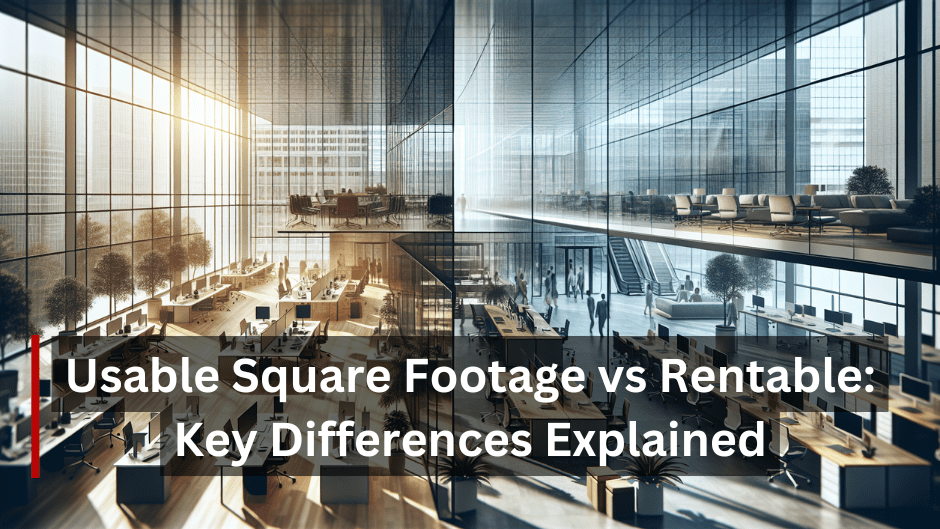
Usable Square Footage vs Rentable: Key Differences Explained
Published At: Mon, 10/14/2024 - 11:23
When it comes to commercial real estate, understanding the difference between usable square footage vs rentable square footage is crucial for both tenants and landlords. These measurements play a significant role in determining lease terms, pricing, and the overall value of office space. Whether you're a business owner looking to lease commercial property or a property manager handling office buildings, grasping these concepts can have a major impact on your decision-making process.
In this article, you'll learn the key differences between usable and rentable square footage. We'll explore how these measurements affect commercial leases, what they mean for tenants and landlords, and why they matter in the world of commercial real estate. You'll also gain insights into how common areas factor into these calculations and how understanding these measurements can help you make informed choices when leasing or managing office space.
Understanding Commercial Real Estate Measurements
In commercial real estate, accurate measurements are crucial for determining lease terms, pricing, and property value. The industry relies on standardized methods to ensure consistency and fairness in these calculations. You'll find that understanding these measurements is essential for making informed decisions when leasing or managing office space.
Importance in Leasing
Square footage has a major impact on leasing because it determines the economic terms of the deal. When you're negotiating a lease, the agreed-upon square footage affects your base rent, operating expenses, and taxes. Landlords and tenants often settle on a fixed annual rent paid in monthly installments, calculated at a cost per square foot. Additionally, your share of common area maintenance (CAM) charges is typically based on your percentage of the building's total square footage.
Given how closely the economics of a lease are tied to square footage, it's crucial to understand how it's calculated. Surprisingly, there's no single standardized method for measuring leased space in the real estate industry. Different measuring techniques can benefit either the landlord or the tenant, so it's important to know which method is being used.
Industry Standards and Practices
To address the need for consistency, the Building Owners and Managers Association (BOMA) has established widely recognized standards for measuring commercial real estate space. BOMA published its first office standard in 1915 and has continued to update its guidelines to reflect changing market needs and building designs.
BOMA standards provide a practical guide for consistently measuring and reporting square footage across various property types. These standards are reviewed at least every five years to ensure they remain relevant. By applying these standards appropriately, you can directly impact a commercial property's value.
Different types of commercial properties may use different BOMA standards. For example, office buildings and shopping centers with multiple tenants and common areas often use the Rentable Square Footage method. This includes not only the actual space you lease but also your pro-rata share of common areas like lobbies, hallways, and bathrooms. On the other hand, warehouses and industrial buildings with single tenants might use the Gross Square Footage method, which is often more logical for these types of properties.
Usable Square Footage: The Tenant's Perspective
Definition and Calculation
When you're looking to lease office space, understanding usable square footage is crucial. It represents the actual area you'll occupy within the leased premises. This includes your private offices, meeting rooms, workstations, and any other spaces exclusively for your use. To calculate usable square footage, you measure from the outer surface of exterior walls and windows, including the middle of interior walls adjacent to other spaces or common areas.
What's Included and Excluded
Usable square footage includes all the floor space within the walls of your leased area. For partial floor tenants, this encompasses your office space, storage areas, and private restrooms. If you're leasing an entire floor, it also includes floor-specific common areas like kitchenettes and reception areas. However, it's important to note that usable square footage doesn't include shared spaces such as lobbies, public corridors, elevators, or stairwells.
Importance in Space Planning
Understanding your usable square footage has a major impact on space planning for your business. It helps you determine if an office is the right size for your needs. You'll use this measurement to plan your office layout, ensuring there's enough room for your employees, equipment, and any special requirements your business might have.
When evaluating potential office spaces, it's crucial to consider both usable and rentable square footage. Focusing solely on rentable square footage might lead to unpleasant surprises, as you could end up with less usable space than expected. To avoid this, it's recommended to measure the space yourself or have an architect field measure it, especially for areas over 5,000 square feet.
Remember, the usable square footage is what you'll actually work with, so it's essential to ensure it meets your operational needs. By understanding this concept, you'll be better equipped to make informed decisions when leasing commercial property and planning your office space.
Rentable Square Footage: The Landlord's Approach
Definition and Components
Rentable square footage (RSF) is a crucial concept in commercial real estate that landlords use to determine the total leasable area of a property. It includes the usable square footage (USF) of a tenant's space plus a proportionate share of the building's common areas. These common areas typically encompass shared spaces such as lobbies, hallways, elevators, stairwells, and amenities like fitness centers or conference rooms. The RSF is the basis for calculating rent and other charges in a commercial lease.
Load Factor Explained
The load factor, also known as the common area factor, is a key component in understanding rentable square footage. It represents the ratio between the rentable square footage and the usable square footage. To calculate the load factor, you divide the total rentable square feet of a building by its total usable square feet. For example, if a building has 115,000 rentable square feet and 100,000 usable square feet, the load factor would be 1.15 (115,000 / 100,000). This means that for every square foot of usable space, tenants are paying for an additional 15% in common areas.
Impact on Lease Rates
The rentable square footage has a major impact on lease rates and the overall cost of occupancy for commercial tenants. Landlords use the RSF to determine the base rent, which is typically calculated by multiplying the RSF by the rental rate per square foot. This approach ensures that tenants contribute to the maintenance and upkeep of common areas they benefit from, even if they don't directly occupy those spaces.
For tenants, it's crucial to understand the difference between usable and rentable square footage when evaluating lease options. A higher load factor means paying for more common area space, which can significantly affect the overall cost of the lease. However, buildings with higher load factors may offer more amenities or prestige, which could justify the additional expense for some businesses.
Conclusion
Understanding the distinction between usable and rentable square footage is key to making smart decisions in commercial real estate. These measurements have a big impact on lease terms, pricing, and the overall value of office space. For tenants, grasping these concepts helps in planning office layouts and budgeting, while landlords use them to determine fair lease rates and manage property values effectively.
To wrap up, whether you're leasing or managing commercial property, knowing the ins and outs of usable and rentable square footage is crucial to navigate the market successfully. It's all about finding the right balance between space efficiency and cost-effectiveness. For expert guidance on commercial real estate matters, feel free to call (888) 518-9168. By staying informed about these measurements, you'll be better equipped to make choices that align with your business needs and financial goals.


